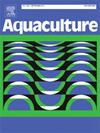Three-way crossed scallops between Argopecten irradians irradians, A. i. concentricus and A. purpuratus exhibit strong heterosis in growth, survival and temperature tolerance
IF 3.9
1区 农林科学
Q1 FISHERIES
引用次数: 0
Abstract
The bay scallops, including the northern subspecies Argopecten irradians irradians (NN) and southern subspecies A. i. concentricus (SS), are economically important cultured bivalves in China. Due to their hermaphroditic nature, the currently farmed bay scallops often suffered from significant inbreeding depression characterized by slow growth, high mortality and low-stress tolerance, especially in the hot summers. In this study, to further improve the production performance and stress resistance of bay scallops, we first conducted a two-way intraspecific hybridization between the two subspecies of the bay scallops (NN and SS), and then hybridized the two-way hybrids with the Peruvian scallop, A. purpuratus (PP) and obtained two three-way hybrids, NSP and SNP. During embryonic and larval stages, both two three-way hybrids exhibited higher fertilization rate, hatching rate and metamorphosis rate, larger initial D-larvae size, and faster embryonic development and larvae growth than those of their parental stocks. The two three-way crossed hybrids displayed excellent heterosis in both growth and survival at larval stage. Both egg origin and mating strategy had significant effects on growth at the larval stage, while the survival rate was mainly dictated by mating strategy. At adult grow-out stage, the heteroses in NSP and SNP cohorts were 12.36 and 19.92 in shell height, 40.37 and 53.27 in whole body weight, and 13.73 and 21.13 in survival rate at harvest, respectively. Moreover, temperature stress tolerance was significantly improved in the three-way crossed scallops. The gonads of most three-way crossed hybrids seemed to be morphologically and functionally females, although the fertility of eggs was very low, suggesting that more energy would be allocated for growth and survival. Notably, the genetic diversity was increased in both three-way hybrids. Therefore, the three-way crossed scallops are potentially precious breeding material for selecting new scallop strains and can be potentially widely cultured along both the southern and northern China coasts.
Argopecten irradians irradians、A. i. concentricus 和 A. purpuratus 之间的三元杂交扇贝在生长、存活和耐温性方面表现出很强的异质性
海湾扇贝,包括北方亚种 Argopecten irradians irradians(NN)和南方亚种 A. i. concentricus(SS),是中国重要的经济养殖双壳贝类。由于其雌雄同体的特性,目前养殖的海湾扇贝经常遭受严重的近亲繁殖抑制,其特点是生长缓慢、死亡率高、抗应激能力低,尤其是在炎热的夏季。在本研究中,为了进一步提高海湾扇贝的生产性能和抗逆性,我们首先在海湾扇贝的两个亚种(NN和SS)之间进行了双向种内杂交,然后将双向杂交种与秘鲁扇贝A. purpuratus(PP)杂交,得到了两个三向杂交种NSP和SNP。与亲本相比,两个三向杂交种在胚胎期和幼体期均表现出较高的受精率、孵化率和变态率,初始D型幼体较大,胚胎发育和幼体生长速度较快。两个三系杂交种在幼虫期的生长和存活率方面都表现出很好的异质性。卵源和交配策略对幼虫期的生长均有显著影响,而成活率则主要受交配策略的影响。在成虫生长阶段,NSP 和 SNP 组群在壳高方面的异质性分别为 12.36 和 19.92,在全体重方面的异质性分别为 40.37 和 53.27,在收获成活率方面的异质性分别为 13.73 和 21.13。此外,三系杂交扇贝对温度胁迫的耐受性明显提高。虽然卵的受精率很低,但大多数三向杂交种的性腺在形态和功能上似乎都是雌性的,这表明更多的能量将用于生长和存活。值得注意的是,两种三向杂交种的遗传多样性都有所增加。因此,三向杂交扇贝可能是选育扇贝新品系的珍贵育种材料,可在中国南部和北部沿海广泛养殖。
本文章由计算机程序翻译,如有差异,请以英文原文为准。
求助全文
约1分钟内获得全文
求助全文
来源期刊

Aquaculture
农林科学-海洋与淡水生物学
CiteScore
8.60
自引率
17.80%
发文量
1246
审稿时长
56 days
期刊介绍:
Aquaculture is an international journal for the exploration, improvement and management of all freshwater and marine food resources. It publishes novel and innovative research of world-wide interest on farming of aquatic organisms, which includes finfish, mollusks, crustaceans and aquatic plants for human consumption. Research on ornamentals is not a focus of the Journal. Aquaculture only publishes papers with a clear relevance to improving aquaculture practices or a potential application.
 求助内容:
求助内容: 应助结果提醒方式:
应助结果提醒方式:


